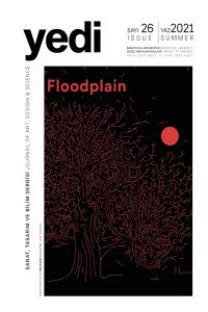Çevre Estetiğinde Kullanılan Modellerin Değerlendirilmesi ve Biyofilya Bağlamında Yeni Bir Model Önerisi
Çevre Estetiği, Biyofilya, Çevre Estetiği Modelleri
Evaluation of Models Used in Environmental Aesthetics and Proposing a New Model in the Context of Biophilia
___
- Abdelaal, M.S. (2019). ‘’Biophilic campus: An emerging planning approach for a sustainable innovation-conducive university’’, Journal of Cleaner Production, 215, 1445-1456.
- Anonim. (2019). https://www.gizushka.com/biyofili-nedir-kelimekolik/ (02.09.2019).
- Bayraktaroğlu, Ö. E. (2014). Mimarlıkta ekosistem düşüncesiyle tasarlamak. Doktora Tezi. İstanbul Teknik Üniversitesi Fen Bilimleri Enstitüsü, İstanbul.
- Berleant, A. (1992). The eesthetics of environment. Philadelphia: Temple University Press.
- Brown, D.K., Barton, J.L., Gladwell, V.F. (2013). ‘’Viewing nature scenes positively affects recovery of autonomic function following acute mental stress’’, Environ Sci Technol, 4, 5562–5569.
- Carlson, A. (1979). ‘’Appreciation and the natural environment’’, The Journal of Aesthetics and Art Criticism’’, 3, 267-275.
- Carlson, A. (2000). Aesthetics and the environment: The appreciation of nature, Art and architecture. New York: Routledge.
- Carlson, A. and Berleant, A. (2004). ‘’Introduction: The aesthetics of nature’’. In Carlson A. Berleant A. (Ed.), The Aesthetics of Natural Environments (p.11-42), Canada: Boardview Press.
- Carlson, A. and Lintott S. (2008). ‘’Introduction: natural aesthetic value and environmentalism’’. In Carlson A. Lintott S. (Ed.), Nature, Aesthetics, and environmentalism: From Beauty to Duty (p.1-22), USA: Columbia University Press.
- Carlson, A. (2009). Nature and landscape : An introduction to environmental aesthetics. New York: Columbia University Press.
- Çorakçı, R.E. (2016). İç mimarlıkta biyofilik tasarım ilkelerinin belirlenmesi (Yayımlanmamış Doktora Tezi). Mimar Sinan Güzel Sanatlar Üniversitesi Fen Bilimleri Enstitüsü, İstanbul.
- Eleonora, G. (2000). ‘’ The biophilia hypothesis and life in the 21st century: Increasing mental health or increasing pathology?’’, Journal of Happiness Studies, 1, 293-322.
- Gilpin, W. (1792). Three essays: on picturesque beauty, on picturesque Travel, and on the sketching landscape, London: Balmire.
- Heerwagen, J., Orians, G. (1993). Biophilia hypothesis. Washington: Island Press.
- Hepburn, R. (2004). ‘’Contemporary aesthetics and the neglect of natural beauty’’. In Carlson A. Berleant A. (Ed.), The Aesthetics of Natural Environments (p.11-42), Canada: Boardview Press.
- Ikei, H., Komatsu, M., Song, C.R. (2014). ‘’The physiological and psychological relaxing effects of viewing rose flowers in office workers’’, Journal Physiol Anthropol, 33, 1–5.
- Knight, R. P. (1794). The landscape. London: Bulmer.
- Nieuwenhuis, M., Knight, C., Postmes, T. (2014). ‘’The relative benefits of green versus lean office space: three field experiments’’, Journal Exp. Psychol. Appl., 20, 199–214.
- Price, U. (1794). An essay on the picturesque. London: Robson.
- Rosley, M.S., Abdul Rahman, S.R., Lamit, H. (2014). ‘’Biophilia theory revisited: Experts and non-experts perception on aesthetic of ecological landscape’’, Procedia-Social and Behavioral Sciences, 153, 349-362.
- Sanchez, J.A. Ikaga, T. Sanchez, S.V. (2018). ‘’Quantitative improvement in workplace performance through biophilic design: A pilot experiment case study’’, Energy and Buildings, 177, 316-328.
- Saito, Y. (1999). Everyday aesthetics. USA: Oxford University Press.
- Sepänmaa, Y. (1986). The beauty of environment: A general model for environmental aesthetics.USA: Environmental Ethics Books
- Tuan, Y. F. (1974). Topohilia, a study of environmental perception, attitudes, and values. USA: Columbia University Press.
- Ulrich, R. S. (1993). ‘’Biophilia, biophobia and natural landscape’’. In S R. Kellert S. Wilson E.O (Ed.), Biophilia Hypothesis (p. 73-137), USA: Island Press.
- Van den Berg, A.E. Hartig, T. Staats, H. (2007). ‘’Preference for nature in urbanized societies: Streets, Restoration, and the Pursuit of Sustainability’’, Journal of Social Issues, 63, 88-89.
- Wilson, E. O. (1984). Biophilia. USA: Harvard University Press.
- Wilson, E. O. (1996). In search of nature. Washington: Harvard University Press.
- Zhang, W., Goodale, E., Chen, J. (2014). ‘’How contact with nature affects children’s biophilia, biophobia and conservation attitude in China’’, Biological Conservation, 177, 109-116.
- ISSN: 1307-9840
- Başlangıç: 2007
- Yayıncı: Dokuz Eylül Üniversitesi
Sokak Sanatında Üsluba Dair Yorumlar ve Muhalif Boyut
Harlem Rönesansı'nın Amerikan Resim Sanatı Üzerine Etkileri
Saeideh ABDOLLAHİ, Hilmi Ekin OKTAY
Program Müziği Kavramına Hermeneutik Bir Yaklaşım
Sanat ve Kültür Yönetimi Eğitimi: Tarihsel ve Karşılaştırmalı Bir Giriş Denemesi
Retorik, İkna ve Tasarım Jürisi
Yerelleştirme Süreçlerinde Metinlerarası ilişkilendirmelerin Rolü: Suskunlar Örneği
Fotoğraf Sanatında Kusur Kavramının Bilinçli Kusur Bağlamında Yeniden Sunumu
Postmodern Dönemde Yeni Bir Tanım Arayışı: Müellif Olarak Grafik Tasarımcı
